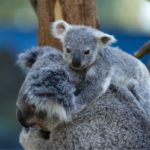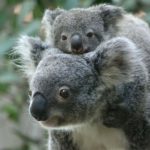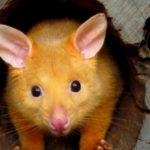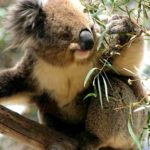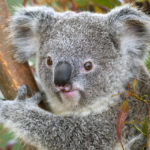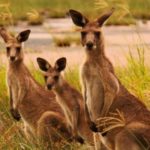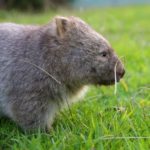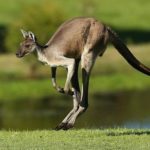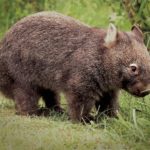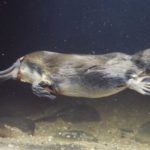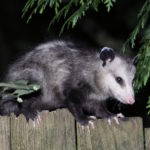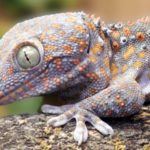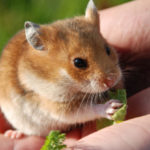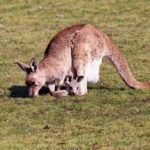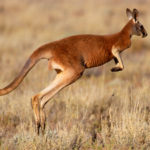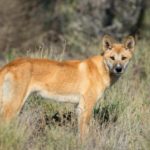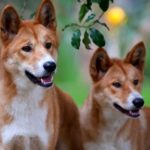Koalas
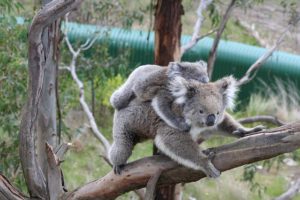 Koala is an animal that lives in the natural habitat of Australia (Queensland and Victoria). Koala is a marsupial mammal. Therefore, it would be wrong to consider Koala, belonging to the mammalian family of Kangaroo Wallabi, Kangaroo Tree and Opposum, etc. Marsupial mammals are a special kind of mammal that not only feed their young offspring with milk, they also possess a sac for carrying offspring (only females), until the offspring reach a certain level of adult life. Therefore, koalas feed their offspring (Koala Joey), and also keep them in pouches (bags) for a certain period of time until the offspring mature for independent living in the wild.
Koala is an animal that lives in the natural habitat of Australia (Queensland and Victoria). Koala is a marsupial mammal. Therefore, it would be wrong to consider Koala, belonging to the mammalian family of Kangaroo Wallabi, Kangaroo Tree and Opposum, etc. Marsupial mammals are a special kind of mammal that not only feed their young offspring with milk, they also possess a sac for carrying offspring (only females), until the offspring reach a certain level of adult life. Therefore, koalas feed their offspring (Koala Joey), and also keep them in pouches (bags) for a certain period of time until the offspring mature for independent living in the wild.
Koalas live on earth for more than 30 million years and, in particular, on the Australian continent. It is estimated that about 50 million years ago they migrated from Antarctica to Australia, when Australia separated from Antarctica. During this time and until now, koalas have certainly gone through various kinds of transformation and evolutionary periods. However, many researchers and observers say that even during this long period, the koala remained almost the same, with very little changes in their physical properties. Therefore, koala today can be relatively similar to a koala 30 million years ago.
In itself, the word “koala” denotes the absence of water. Local people in Australia who observed and determined that the animal does not drink water at all throughout its life, but eats other food-eucalyptus leaves-specifically designed the name of a koala. The Australian settlers did not notice the koalas at once and almost ten years after their resettlement, but they believe that the coales as a separate species live throughout the continent of Australia.
Koalas are often considered the most beautiful and cute animals in Australia. For this reason, they are even more popular than kangaroos. However, outside of Australia – all over the world – it is kangaroos that are recognized as the main symbol of this country. Although in Australia itself the most popular animal is, of course, the koala. But it would be unfair to say that a koala is more attractive than a teddy bear, because outwardly they are almost the same. With the only difference is that the face of the koalas is clearly prettier than that of the teddy bears.
The Koala has rounded ears, this is not seen with an armed eye. Another feature of the koala’s ears is their fluffiness, if you touch it you can feel it. The Koala has a dark and big nose. According to some observers, the shape reminds of a spoon, there is also the assertion that the nose of a koala is similar to a small cut of an elephant’s trunk.
Koalas vary depending on their shape and size. Some Koalas are less genetically, while other Koalas are genetically larger. Usually koalas from Victorian territories of Australia are more, in comparison with koalas from territory of Queensland in Australia. In addition, the male Koala is also larger than the female. The male Koala from Victoria is about 16 kilograms compared to the male koala from Queensland, which is about 10 kilograms. A female koala from Victoria is about 12 kilograms, while a koala female from Queensland is about 7 kilograms. Thus, depending on gender, as well as territorial affiliation, koalas do show a certain degree of change in terms of their size.
Another bright distinctive feature of the koala is their eye. They are usually dark brown in color and resemble marble balls. According to our observations, they are similar in shape to buttons. If you need to distinguish a koala, it’s just as easy to make on their rounded fluffy ears, a large black nose, similar in shape to a spoon, and eyes – marble balls. Another important feature inherent in koalas is that they belong to the largest mammals, climb trees through the entire Australian continent. When we talk about koalas, we mean the largest animal living on trees in a natural habitat in Australia.
Life in the common habitat for koalas, in the first place, causes, for the most part, problems throughout their life. Koalas have a limited choice of food. Teeth koalas are prone to tooth decay from the moment they reach their maturity. And most importantly: koalas are defenseless mammals, they become victims of the simplest predators that inhabit the continent of Australia. In fact, problems with teeth are one of the biggest problems for koalas. Koalas maintain a very selective diet, which includes eucalyptus leaves. They must constantly grind these leaves. The process of grinding eucalyptus leaves adversely affects the triggers – this is how the process of tooth decay occurs immediately with the onset of the maturity period.

